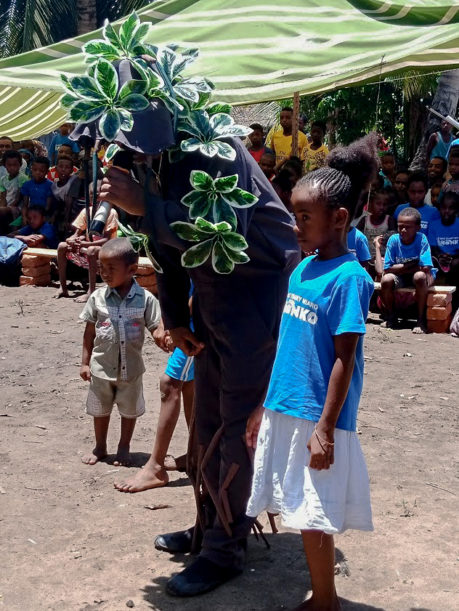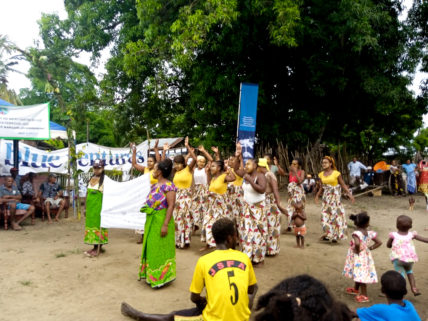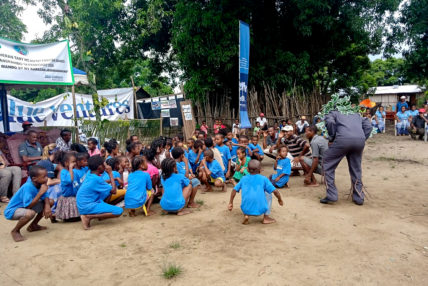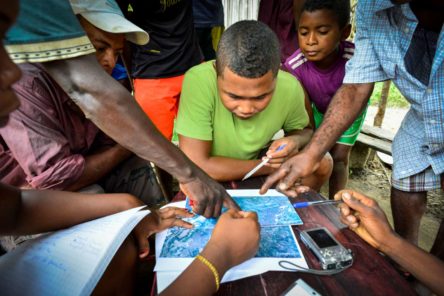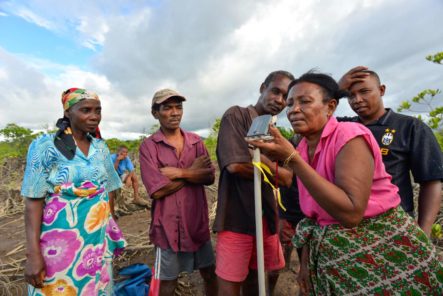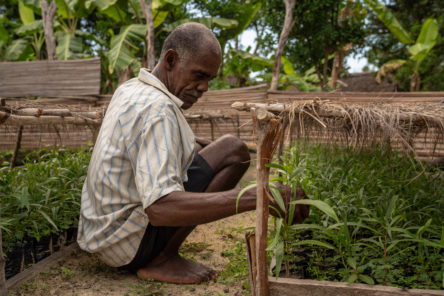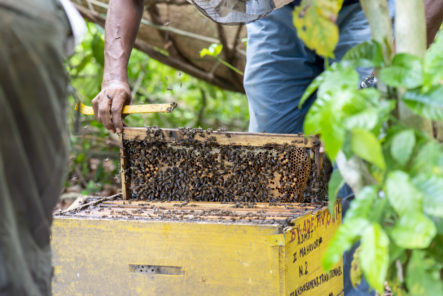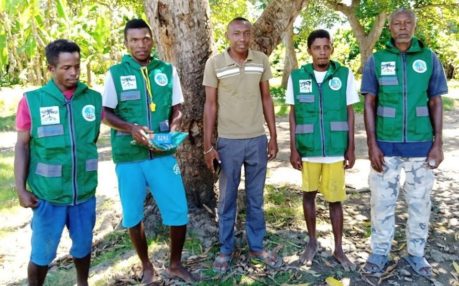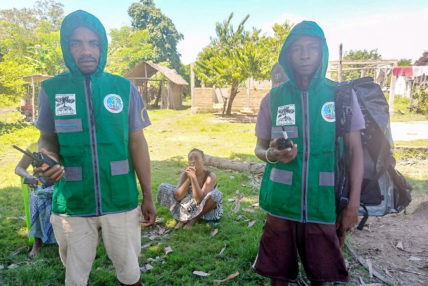I have been working in locally led marine conservation for almost 12 years now. I started my journey supporting community-led octopus fishery closures in Andavadoake, southwest Madagascar, before moving up to the northwest – home to the second largest mangrove forest in Madagascar – to support community-led mangrove management in Tsimipaika Bay. Since 2008, there has been a massive decrease of the mangrove surface area in the region due to exploitation for charcoal production, with mangrove loss estimated at around 3.4% per year.
This loss is threatening the livelihoods of the local communities, as more than 70% of income opportunities depend on fisheries activities such as finfish, crab and sea cucumber fishing. In parallel to the diminishing mangroves, fishers have also noticed their daily catch decrease, as mangroves are a nursery for many species of fish and shrimp.
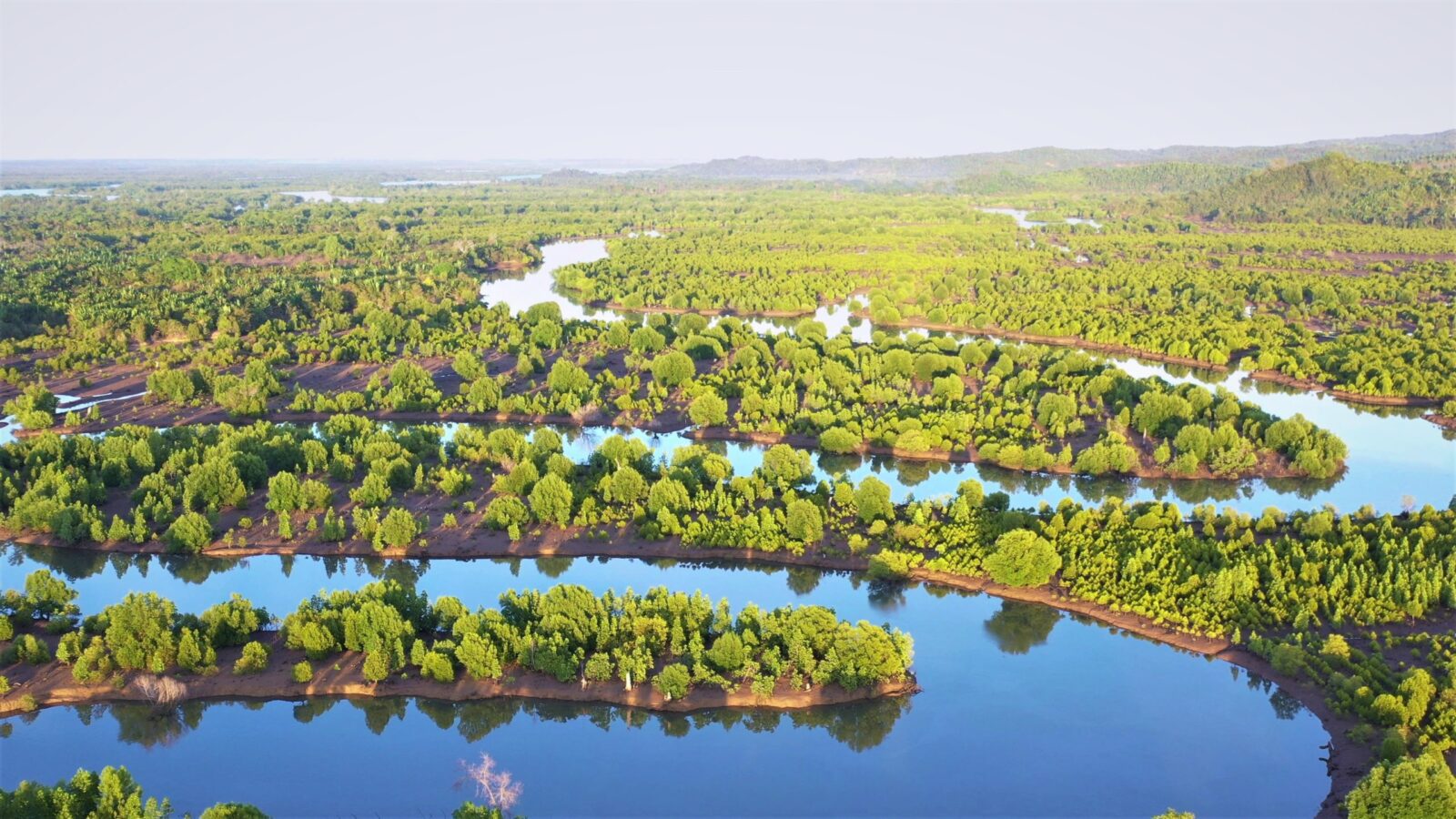
A birds-eye view of the mangroves in Tsimipaika Bay | Photo: Zo Andriamahenina
Since 2000, community-led mangrove management associations known as Vondron’olona Ifotony (VOI) have been in place in every village in Tsimipaika Bay. The government has adopted a strategy of transferring natural resources management authority to the VOIs in order to involve communities in the management of the mangrove forests and marine resources on which they depend.
As Blue Ventures’ mission is to support remote coastal communities to rebuild their fisheries and preserve their natural resources, we have made our support to VOIs and community-led sustainable mangrove management in Tsimipaika Bay a priority from the start.
However, along the way there have been many nagging questions, such as: why does the pressure on mangroves continue to increase, even after mangrove management has been transferred to fishers communities’ VOIs? What are the barriers to basic community engagement in locally led sustainable management of natural resources?
At Blue Ventures, we are committed to acknowledging, understanding and addressing this disparity in a way that considers the needs of local peopleSometimes, when I discuss the challenges within mangroves conservation with other conservation NGO staff or friends, some regret that the government adopts laws around natural resources conservation in a top-down approach without involving local communities in the decision making. Others point out the lack of governmental support and the lack of capacity and funding to provide that support. I agree, in a way. But I also think that there are other barriers – and therefore solutions – to basic community engagement. At Blue Ventures, we are committed to acknowledging, understanding and addressing this disparity in a way that considers the needs of local people.
Speaking to the hearts of the community
Working with communities for almost 12 years, I have often found that the primary reason why communities do not spontaneously engage in sustainable management of their resources, is that they do not realise that it is necessary. Why establish fisheries reserves? What for? They are fishermen like their ancestors. Their ancestors could exploit their resources freely, without community management measures. Today’s fishermen and fisherwomen think they should continue to fish in the same way to get as much catch as the previous generations.
We need to be patient in developing effective strategies to introduce information and initiate exchanges of observationsWe need to be patient in developing effective strategies to introduce information and initiate exchanges of observations. For example, we often use presentations and videos to explain why conservation is important. But whilst some people keenly watch and listen, we’ve learnt that this isn’t always the most effective route of communication.
Recently, on International Wetlands Day, we decided to use a kind of mangrove mascot, called Dadahonko (Papa Mangrove), who told the people in the villages how important it was to protect him. The attentive audience were clearly touched by his words. “I am very moved,” said one woman, “to hear Dadahonko asking not to kill him because the mangroves provide people with food and protect their village from storms”. Her words echoed one message loud and clear; as an NGO, we need to make sure that we speak not only to the heads, but also to the hearts of communities.
Building trust through data reporting
In order to engage in activities proposed by NGOs, communities also need to have a very clear understanding of the mission and approach of these NGOs. In other words: how will the activities meet their needs, not the NGO’s own interests?
For example, when Blue Ventures first presented the fuelwood planting activities in Ambanja and explained the process, some people were not motivated to take part because they thought that Blue Ventures might keep the land afterwards. Similarly, the first time the communities in Tsimipaika Bay saw Blue Ventures staff taking soil samples from the mangroves for a carbon stock study, some people assumed that Blue Ventures wanted to exploit a gemstone that was in the mangrove soil.
Through data reporting sessions, communities understand much more clearly why we need the data and, more importantly, why they need themWe have learned that community engagement on field data collection like this requires clear and regular presentations of the analysis of these data. Through data reporting sessions, communities understand much more clearly why we need the data and, more importantly, why they need them. It is not an easy exercise, but it is crucially important in order to gain the trust of communities.
Inspiring one person to create a movement
Alternative livelihoods is another area where NGOs must carefully consider the needs of communities. Understandably, alternative livelihood proposals aimed at reducing pressure on natural resources do not generate much interest if they are not immediately as profitable as the communities’ current activities, even if the latter are precarious or prohibited, such as charcoal production.
In Ambanja, we are supporting 11 VOIs (about 480 members) in 11 villages on resource management, capacity building, renewal of management contracts and providing materials to community mangrove patrols. We have also developed complementary livelihoods, such as planting fuelwood or beekeeping as alternatives to the occasional – and illegal – exploitation of charcoal. So far, less than 250 people have engaged in these activities due to a lack of interest in some villages.
The number of people involved initially is not important – the key is to have a small group who are really active and engagedAt first glance, this could be discouraging. But we have learned that it takes time to develop livelihood activities until the skills and results are commensurate with the needs. The number of people involved initially is not important – the key is to have a small group who are really active and engaged. I once knew an illegal charcoal producer in Tsimipaika Bay who learnt about the importance of mangrove conservation. Eventually, he became president of his village’s VOI. He is now leading by example, strengthening customary law on mangrove preservation during the COVID-19 crisis. His VOI is a model for others, showing that it only takes one person to understand an idea in order to begin to scale up impact.
Adapting to community needs at times of crisis
As is prevalent along the remote coastlines of Madagascar, communities in the Tsimipaika Bay area are being affected by the socio-economic impacts of the COVID-19 pandemic. As the agricultural and fishing sectors experience a sharp drop in access to regional and national markets, fish prices are falling and rice prices are increasing. The resulting lack of income opportunities, combined with a need for more money to afford rice has meant that many people are turning to the mangroves for a solution. Although illegal, the exploitation of mangroves for charcoal is currently the most ‘accessible’ way for community members to get an alternative income; the price does not change, and the market is easy to access.
To combat this increase in illicit behaviour, the VOIs are relying on their community surveillance teams. For now, the members of the mangrove community surveillance patrols are continuing to work, but if this crisis persists they may have to prioritise their families’ livelihoods and find safer ways to earn money.
More people are likely to convert to charcoal exploitation if we do not quickly find ways to support them. We are currently exploring all possible solutions with our partners to help communities cope with the impact of the COVID-19 crisis. What we have learnt and built with them over the years is an excellent basis for continuing to move forward together.


